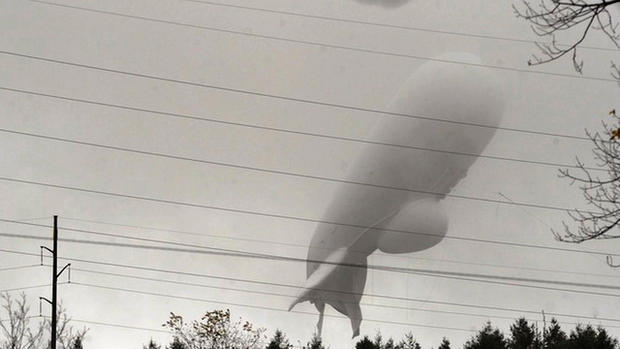Gunshots help deflate runaway military blimp in Pennsylvania
PENNSYLVANIA -- Pennsylvania law enforcement on Thursday used small arms fire to deflate the unmanned runaway Army blimp that broke loose from its ground tether at a military base in Maryland on Wednesday, a Pentagon spokesperson said.
It was deflated because there were fears it could be grabbed by the winds and take off again, the spokesperson said. The blimp is now fully deflated.
The blimp drifted over central Pennsylvania as two Air Force fighter jets tracked it. It was grounded in central Pennsylvania.
A North American Aerospace Defense Command spokesman confirmed to CBS News that the blimp landed in Montour County, Pennsylvania, on Wednesday afternoon. NORAD said the blimp detached from its station at Aberdeen Proving Ground, Maryland, at about 12:20 p.m., and initially traveled north at an altitude of about 16,000 feet.
CBS News national security correspondent David Martin reported on Wednesday that National Guard helicopters were scrambled along the blimp's projected route to secure the crash site and all of the technology on board the blimp when it finally came down.
A Pentagon spokesperson told Martin on Thursday the blimp is a fire control blimp, not the surveillance blimp that was originally reported.
Martin reports that an Army recovery team has arrived to where the blimp is located. The Danville National Guard Armory is being used as the collection point for the pieces. An Army safety investigation will be conducted, but there is no indication of foul play.
Spokesman Capt. Jeff Davis repeated statements from Wednesday, that there was never any serious consideration given to shooting it down, although he did not have any answers to questions about what they would have done if the blimp hadn't come down on its own. Davis said the blimp's auto-deflate mechanism is designed to operate if the tether breaks, but Davis did not know if it was the auto deflate mechanism that caused the blimp to descend.
The blimp's long tether snapped thousands of power lines, causing outages. The local electric utility, PPL, reported about 20,000 customers without power in the area on Wednesday afternoon, although it was unclear how many could be attributed to the blimp. Bloomsburg University canceled classes, citing a "widespread power outage."
Martin reports that there is a process by which people who have suffered damages from the blimp can file a claim with the Army. The Pentagon has no estimate on amount of damage caused at this time.
An official says the military is in the process of removing some 6,000 feet of tether from a surveillance blimp that broke loose from a military facility and came down in two pieces in the Pennsylvania countryside. U.S. Army Captain Matthew Villa says the tail section will be removed Thursday afternoon.
He says the main hull section of the blimp is in the process of deflating and could be taken away in the "next day or so."
When the blimp went down Wednesday, it had helium in the nose which had to be drained. Villa says the "easiest way possible" to do that was to shoot it. He says the state police fired about 100 shells at the white behemoth to get it to deflate.
Some who live in Aberdeen, like Tom Neuberger, have long worried that the blimp would get loose and crash into their neighborhood.
"Fly it into a hurricane, but don't fly it over our heads. We have children, retirees, a college, a community," he said to CBS News' Chip Reid. "We want to be safe from this kind of military mismanagement."
The Army has long argued the blimps present no danger to the public. But the heavy tether dragged along the ground for miles taking out power lines and damaging the greenhouse business where Megan Church works.
"It ripped the plastic, ripped the pipe, destroyed benches," she told Reid. "Thank God no one was hurt."
There are only two of these blimps in existence -- the fire control one which went down and the surveillance one that is now grounded, apart of a $2.6 billion, 10 year long program.
The blimp is the kind used extensively in the Iraq and Afghanistan wars to provide ground surveillance around U.S. bases and other sensitive sites.
"My understanding is, from having seen these break loose in Afghanistan on a number of occasions, we could get it to descend and then we'll recover it and put it back up," Defense Secretary Ash Carter said in a brief exchange with reporters at the Pentagon on Wednesday. "This happens in bad weather."
At the time it broke away it was operating within permitted weather minimums.
The F-16s tracking the blimp were launched from the Atlantic City Air National Guard Base in New Jersey, according to the NORAD statement. FAA officials were working with the military to ensure air traffic safety in the area.
As Reid reported in February, the type of unmanned blimp is nearly as long as a football field.
It is being tested for permanent duty scanning the sky for incoming cruise missiles, Reid reported.
The state-of-the-art radar housed in the bubble underneath the unmanned dirigible has a range of 340 miles -- from Boston to North Carolina.

